Abstract
Hydrogen represents an environmentally friendly and renewable energy source that could substitute fossil fuels and diminish greenhouse gas emissions. However, conventional methods of producing hydrogen are frequently expensive, energy-intensive, or detrimental to the environment. This study proposes an innovative and eco-friendly approach for hydrogen production using activated carbon derived from fennel flower waste, an inexpensive agricultural by-product abundant in Qatar. The researchers prepared the activated carbon by carbonizing and chemically activating it with potassium hydroxide, and characterized its properties through various techniques, including scanning electron microscopy, Fourier-transform infrared spectroscopy, and Brunauer–Emmett–Teller analysis. They subsequently evaluated the activated carbon’s catalytic performance in a hydrogen production system utilizing sodium borohydride and water as reactants, comparing the results with those obtained from commercial catalysts such as nickel and platinum. The findings revealed that the activated carbon derived from fennel flower waste exhibited a high hydrogen yield of 99.8%, which was comparable to or even surpassed that of the commercial catalysts. Furthermore, the activated carbon demonstrated good stability and reusability over multiple cycles. This study shows that fennel flower waste can be transformed into a valuable catalyst for hydrogen production, offering a sustainable and environmentally conscious solution for energy generation.
1. Introduction
Over the past few decades, we have observed an increase in water and air pollution, caused by rapid industrialization, population growth, urbanization, and the reckless use of natural resources, among other factors [1]. The amount of waste and number of toxic gases released into the environment is increasing year after year due to the continuous development of industry and progress of civilization. On the other hand, the standards for permissible emissions of pollutants are constantly tightened [2]. The negative effects of fossil fuel use, rising pollution levels, climate change, and a growing global population have prompted the quest for more sustainable, efficient energy sources and energy storage technologies. Hydrogen has emerged as a prospective clean fuel alternative due to its clean-burning features and promise as a renewable energy source [3,4,5]. However, effective hydrogen generation technologies, such as hydrogen evolution reactions (HER), continue to be challenging. To overcome this, researchers have investigated a variety of techniques to increase HER efficiency, including the use of activated carbon generated from fennel flower waste, which has shown promise as a sustainable and effective solution [6]. The invention is distinguished by its capacity to enhance the surface area of catalysts, resulting in better efficiency in separating hydrogen from oxygen in water and lowering hydrogen production costs. This technique not only helps to create clean energy technology, but it also gives a sustainable alternative for recycling agricultural waste, making it a potential initiative that combines environmental innovation with increased sustainable energy production.
Waste-Derived Activated Carbon for Supercapacitors
Nature is full of vast numbers of natural fragrances, which have their own unique benefits and are pleasant to our senses. Many previous studies mention the importance of fennel, which is known as Saunf (Foeniculum vulgare) and belongs to the Apiacae family [7]. The taxonomical classification of fennel is detailed in Table 1. The fennel plant originates from the Mediterranean region, but it can be found in other places over all the world today. India is the greatest manufacturer of fennel in the world.

Table 1.
Taxonomical classification of fennel.
The fennel flower plant has several benefits, including natural abundance, cheap cost, environmental friendliness, simplicity of synthesis, and sustainability [8]. Additionally, in the realm of innovative development, these materials have recently been employed as efficient electrode materials in supercapacitors, which will contribute to mitigating global warming and air pollution by reducing the reliance on fossil fuels across various industries; hence, research into using activated carbon produced from fennel flower waste for hydrogen evolution has shown significant promise. Together, these investigations lay a solid foundation for the possibility of fennel-flower-waste-derived activated carbon in attaining very efficient hydrogen evolution. The processing of Nigella sativa seeds produces a large quantity of fennel flower waste, which is frequently neglected and underutilized. However, because of its high carbon concentration, this waste material may be converted into a valuable resource called activated carbon. This flexible material is well known for its excellent adsorption capabilities, huge surface area, and customizable pore structure, making it suitable for a wide range of applications such as gas storage, environmental remediation, and electrochemical energy conversion (Figure 1) [9].
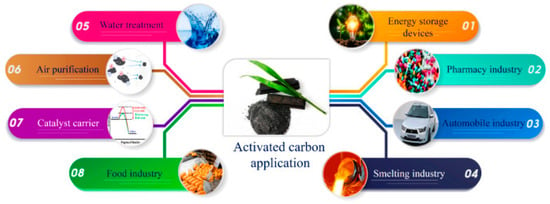
Figure 1.
Applications of AC in different sectors. Reproduced with permission from [9].
Our study focuses on utilizing the potential of activated carbon obtained from fennel flower waste to produce extremely efficient hydrogen. Using agricultural waste to produce activated carbon addresses environmental concerns about waste disposal while also helping the development of sustainable and cost-effective products [10]. The unusual carbonaceous composition of fennel flower waste makes it a good starting point for synthesizing activated carbon with customized features, providing a green alternative to standard carbon precursors [11]. Activated carbon is a class of carbon-based compounds that have undergone activation procedures to increase their porosity and surface area. It is an excellent catalyst for the hydrogen evolution process. However, activated carbon generated from fennel flowers has more stable electrochemical performance than other activated carbons, resulting in increased and better electrochemical qualities. These characteristics include improved cyclic stability, higher energy density, higher power density, and enhanced specific capacitance (Cs). Furthermore, the activated carbon will be mixed with functionalized graphene oxide (FGO) to enhance its electrochemical properties (Scheme 1) [10].
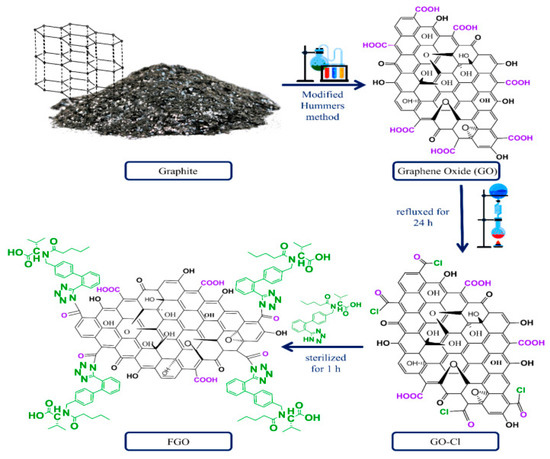
Scheme 1.
Schematic diagram for process FGO preparation. Reproduced with permission from [9].
This study investigates the methods for synthesizing activated carbon from fennel flower waste and evaluates its structural properties and electrochemical performance in connection with hydrogen evolution Figure 2. The goal is to optimize the synthesis process by understanding the link between activation factors, material characteristics, and electrocatalytic activity, which will result in maximum efficiency in HER reactions. The ultimate objective is to create an economically feasible and sustainable process for generating activated carbon catalysts with superior HER performance. This discovery is significant beyond hydrogen evolution since it addresses waste valorization, renewable energy, and environmental sustainability. This work contributes to the circular economy by repurposing fennel flower waste and demonstrates the potential of agricultural waste to promote renewable energy breakthroughs [12].
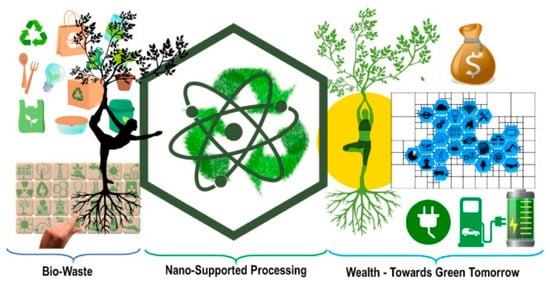
Figure 2.
Agro-waste as sustainable energy. Reproduced with permission from [10].
Our research aims to create a low-cost technique for manufacturing activated carbon from black seed fennel flower biowaste using a simple chemical activation procedure, accelerate the growth of sustainable energy by harnessing innovative renewable sources, and protect the environment by reducing fossil fuel activities across a variety of industrial sectors. In other words, we seek to reduce energy expenses by using low-cost, high-efficiency energy solutions, which will improve economic sustainability and protect the environment from pollution.
2. Experiment
2.1. Preparation of an Activated Carbon (AC) Catalyst
Activation of LC-FF
Activation of LC-FF: LC-FF refers to fennel waste after crushing and burning. Impurities were removed from the LC-FF by first washing it with distilled water and then drying it at 70 °C for 8 h. Then, 10 g of dried LC-FF was added to 100 mL of deionized water. Then, 10 g of KOH was dissolved in 10 mL of deionized water, and then added to the LC-FF. The mixture was then agitated in an aqueous solution (H2O) of deionized water at 70 °C for 2 h, as shown in Figure 3. After 2 h, the mixture was left to cool, and then it was transferred to the centrifuge at 19 °C for 10 min at a rate of 4000 rpm to separate the liquid from the residue. The residue obtained was put into a crucible. The crucible was then transported to a tube furnace, as shown in Figure 3, linked to a nitrogen gas cylinder, allowing the heating process to take place in an inert atmosphere. The gadget was heated at a rate of 7 °C per minute to 450 °C for 2 h. Then, the crucible was removed, and the sample, now activated carbon, was collected. The sample was then crushed and put into 100 mL of 1 M hydrochloric acid (HCl) and left to settle for 5 h to remove potassium hydroxide (KOH), as shown in Figure 3. The precipitate was separated using vacuum filtering, as shown in Figure 3. After that, it was cleaned with water, filtered, and dried in a 90 °C oven for 24 h [13].
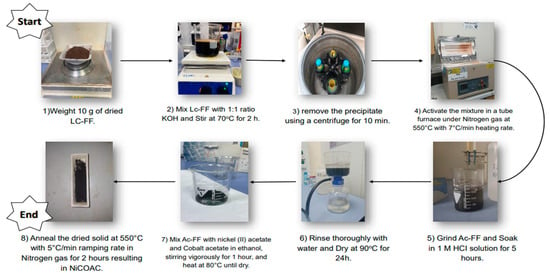
Figure 3.
The steps for preparing cobalt- and nickel-loaded activated carbon from fennel waste.
2.2. Metal Incorporation
After finishing the preceding process, the sample was split into two equal portions, each weighing one gram. One section was left untreated and used as a control for comparison. The remaining fraction (1 g Ac-FF) was mixed with 30 mL of ethanol and 1 g each of cobalt acetate and nickel (II) acetate. The mixture was agitated for an hour and heated to 80 °C until the solvent had evaporated completely. The solid material was subsequently heated in a furnace tube at 800 °C in an inert environment of nitrogen (N2) for 2 h, with a condensation rate of 5 °C/min. Following heating, the sample was allowed to cool and removed from the tube furnace, as shown in Figure 3, yielding a material known as AC-NiCo.
2.3. Characterization Techniques
Transmission electron microscopy (TEM) was used to study the structure and size distribution of particles and crystals in the active carbon. The TEM investigation was conducted using an FEI Tecnai G2 STwin FEG 200 kV. AC-NiCo powder samples were dispersed in isopropanol and then drop-cast onto a standard carbon film copper grid. X-ray diffraction (XRD): The investigation was performed using a Cu Kα radiation source with a wavelength of 0.1541 nanometers. Measurements were taken using a Bruker D8 Advance diffractometer between 10 and 90 degrees. This approach was used to determine the crystalline structure of the active carbon and the size and distribution of its crystals. Fourier-transform infrared spectroscopy (FTIR): Surface functional groups in the activated carbon were identified via FTIR analysis. The examination was carried out using a PerkinElmer Spectrum 400 FT-IR spectrophotometer with spectrum data spanning from 4000 cm−1 to 400 cm−1. This study sought to evaluate the chemical bonds in the active carbon and validate the existence of major functional groups required for electrochemical activity [14].
Scanning Electron Microscopy (SEM)
An ultra-high resolution field emission scanning electron microscopy (FE SEM) (NOVA NanoSEM 450, FEI Co., Ltd., Hillsboro, OR, USA) was used to evaluate sample surface morphology as well as the porous structure of the active carbon. Raman spectroscopy: The active carbon sample was analyzed using the DXR Raman technique, which captures Raman signals released by the sample when illuminated by a laser. Interpreting these signals revealed information on the sample’s chemical composition and molecular structure, and identified current compounds and amounts. The DXR Raman equipment was used to determine the composition and chemical content of the active carbon sample [11]. Electrochemical test: Water electrolysis for the hydrogen evolution process (HER) was conducted using a three-electrode Gamry potentiometer (Model: Reference 3000, Gamry Co., Warminster, PA, USA). The counter electrode was constructed of platinum (Pt) wire, while the reference electrode was composed of Ag/AgCl. The catalyst was used to modify glassy carbon (GC), which served as the working electrode. The catalyst ink was generated by dispersing 5.0 mg of each catalyst in a solution of ethanol and water (2/1 v/v ratio) and adding 50.0 μL of Nafion solution (0.05 wt.%). The mixture was exposed to sonication for an hour to achieve equal dispersion. After that, the ink was drop-cast onto a painstakingly polished GC electrode and dried in a vacuum oven at 60 °C for an hour. The metal mass loading of the catalysts on the GC electrode was found to be 0.02 ± 0.002 mg/cm2 using inductively coupled plasma optical emission spectrometry (ICP-OES).
3. Results and Discussion
The conversion of fennel flower waste into activated carbon shows potential for highly efficient hydrogen evolution. SEM analysis reveals a notable difference between the two materials, with activated carbon exhibiting surface pores that enhance its adsorption capacity. TEM analysis provides nanoscale insights into the deposition of NiCo nanoparticles on biochar, displaying well-defined lattices and clear crystal fringes. XRD analysis confirms the successful modification of activated carbon with nickel cobalt acetate, showing distinct diffraction peaks indicative of crystalline catalysts. FTIR analysis indicates changes in carbon surface chemistry following metal addition, suggesting the effective incorporation of nickel and cobalt species. Raman analysis reveals specific chemical bonds and structural characteristics associated with nickel and cobalt, indicating their successful integration into the biochar structure. These findings collectively demonstrate the potential of activated carbon derived from fennel flower waste for various environmental and renewable energy applications.
3.1. SEM
Comparing the SEM images of fennel waste before and after conversion to activated carbon reveals a significant difference. Figure 4 shows a surface without pores on the fennel residues, while Figure 5 clearly displays pores on the surface of the activated carbon. This indicates that the conversion process created pores on the material’s surface, enhancing the activated carbon’s adsorption capacity. Figure 5 shows that an increase in the active sites for charge transfer caused the further enhancement of electrochemical performance. Increasing the specific surface area will eventually increase the specific capacitance of the proposed material [15].
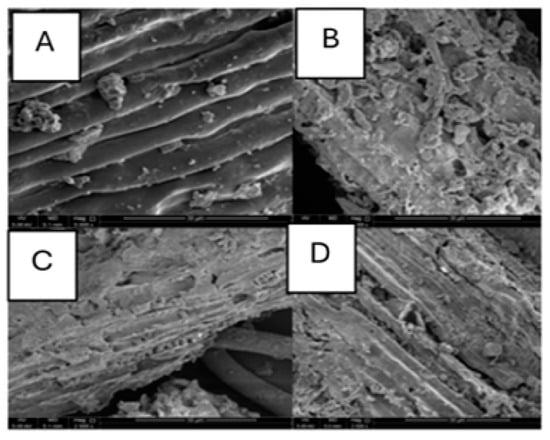
Figure 4.
SEM images of the fennel waste sample before conversion to activated carbon show minimal porosity on the surface as shown in (A–D) indicating a dense.
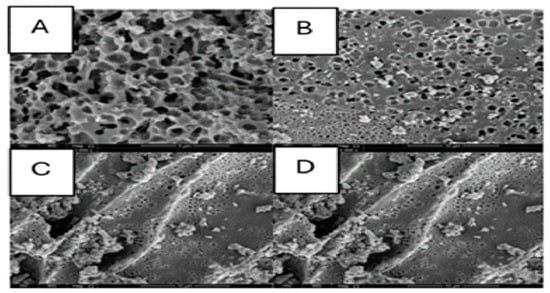
Figure 5.
SEM images of the fennel waste sample after conversion to activated carbon, displaying a large amount of surface porosity, as shown in (A–D), indicating a highly porous and textured structure.
3.2. TEM
The detailed examination using high-resolution transmission electron microscopy (TEM) offers valuable insights into the nanoscale structure of NiCo nanoparticles deposited on biochar. Figure 6a,b depict plain biochar without any metal deposits, representing the pure form of activated carbon. In contrast, Figure 6c,d show activated carbon with embedded NiCo nanoparticles. Figure 6e presents a high-resolution TEM image revealing the fine dispersion of NiCo nanoparticles attached to the biochar surface. These nanoparticles exhibit well-defined lattices and clear crystal fringes, indicating a highly crystalline nanostructure with primary particle sizes ranging from 2 to 5 nm. Furthermore, the selected area electron diffraction (SAED) pattern in Figure 6f displays distinct diffraction spots, confirming the single crystallinity of the nanoparticles. The indexing of the pattern identifies diffraction rings corresponding to the (111), (200), and (220) planes of face-centered cubic NiCo alloy nanocrystals. This thorough analysis confirms the successful impregnation of crystalline NiCo nanoparticles on the biochar, enabling the study of nanoparticle morphology, crystallinity, and phase—all crucial structural characteristics influencing catalyst performance.
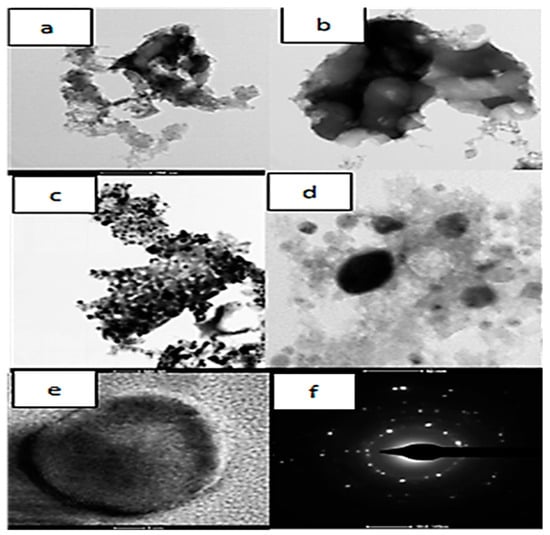
Figure 6.
(a,b) TEM images of plain biochar without metals, (c,d) activated carbon with NiCo nanoparticles, and (e,f) nanoparticles placed within the matrix at different scales.
This work has illustrated the considerable potential of employing activated carbon produced from fennel flower waste for extremely efficient hydrogen evolution, based on the data obtained using TEM and SEM instruments. While NiCo nanoparticles with the correct size distribution for catalytic activity were well dispersed and visible in the TEM imaging, the SEM examination unveiled a hierarchical porous structure that was perfect for mass transport and large surface area. The material’s promising performance in hydrogen evolution processes is attributed to these structural properties. However, future research should concentrate on a few crucial areas to customize this study further, particularly in hydrogen evolution applications employing fennel flower waste. To further customize this research for applications utilizing fennel flower waste for hydrogen evolution, future research ought to concentrate on a few key areas. It will be essential to optimize the synthesis procedure to increase the material’s endurance and catalytic performance. To optimize the advantageous porous structure shown in the SEM, this will entail adjusting carbonization and activation conditions. It will also entail investigating various metal-doping techniques to attain the optimal nanoparticle dispersion seen in TEM. Direct observations of how the distinct structural characteristics of activated carbon derived from fennel flowers contribute to its catalytic performance can be obtained by conducting in situ SEM and TEM studies during hydrogen evolution reactions. This will provide important insights into the material’s behavior under operating conditions. To find possible synergistic effects that improve hydrogen evolution performance, future study will concentrate on combining activated carbon generated from fennel flowers with other catalytic materials using high-resolution microscopy. Furthermore, for practical implementation, it will be essential to scale up manufacturing techniques while maintaining the advantageous structural features seen in laboratory research. To guarantee that the long-term advantages of employing fennel flower waste are fully realized in commercial applications, thorough life cycle assessments and techno-economic studies will evaluate the economic feasibility and environmental effect.
3.3. XRD and FTIR Analysis
Figure 7a illustrates X-ray diffraction (XRD) patterns comparing plain activated carbon with NiCo-modified activated carbon, highlighting clear differences that indicate the effective modification of the activated carbon with nickel cobalt acetate. The XRD pattern of the plain activated carbon shows a broad peak centered around 2θ at 25°, indicating its amorphous carbon structure, consistent with JCPDS card no. 75-1621. In contrast, the XRD patterns of the two modified materials exhibit well-defined diffraction peaks, indicating their crystalline nature. These peaks appear at 2θ values of 26.6°, 44.2°, 53.0°, 75.9°, and 92.3°, corresponding to the (111), (200), (220), (311), and (222) planes of the face-centered cubic (FCC) structure of NiCo alloy nanoparticles, respectively, which closely match JCPDS card no. 15-0806 for NiCo alloy. The presence of these characteristic diffraction peaks confirms the formation of NiCo alloy nanoparticles on the activated carbon support. The calculated crystallite size of the NiCo alloy nanoparticles from the XRD data using the Scherrer equation was approximately 12 nm. In summary, the XRD analysis provides compelling evidence for the successful synthesis of NiCo alloy nanoparticles on the activated carbon support [16]. Fourier-transform infrared (FTIR) analysis provides valuable insights into the characteristic functional groups of the adsorbed materials on the surface of porous carbons. Figure 7b presents the FTIR spectra of both the activated carbon and the AC-NiCo sample. Changes in the relative intensities of certain peaks indicate alterations in the carbon surface chemistry following the addition of metal and annealing. A broad band observed at 3400 cm−1 corresponds to the O–H stretching vibrations associated with adsorbed water or hydroxyl groups on the activated carbon’s surface [17]. Peaks at 1600 cm−1 and 1410 cm−1 in the activated carbon, attributed to aromatic C-C vibrations, shift to various positions for AC-NiCo. The presence of a peak at 1210 cm−1 in AC associated with C–O shifts to 1007 cm−1 after modification in AC-NiCo. Additional peaks appear, associated with metal oxides, such as the band at 874 cm−1 corresponding to Co–O from sp3 hybridized carbon, and the band at 430 cm−1 indicating the formation of Ni–O bonds. These spectra suggest the successful incorporation of nickel and cobalt species into the activated carbon structure.
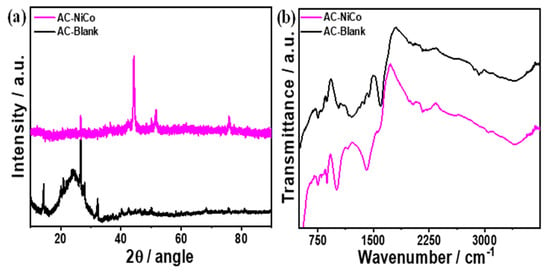
Figure 7.
(a) XRD patterns and (b) FTIR spectra for activated carbon without (AC) and with nickel cobalt doping (AC-NiCo).
While these results demonstrate the successful synthesis and modification of the activated carbon, it is important to note that they do not directly establish the material’s efficacy for hydrogen evolution reactions (HERs). To make this research more specific to HER applications using fennel-derived materials, future work should focus on several key areas. Detailed electrochemical characterization for HERs, including linear sweep voltammetry, Tafel slope analysis, and electrochemical impedance spectroscopy, would be crucial. Comparative studies evaluating the HER performance against standard catalysts and other biomass-derived carbons would help benchmark the material’s effectiveness.
The optimization of the synthesis process for enhanced HER activity is another important avenue, involving the exploration of parameters such as metal ratios, activation conditions, and additional dopants. To gain deeper insights, mechanistic investigations using in situ and in operation techniques should be employed to understand how the unique properties of fennel-derived activated carbon contribute to HER activity. Long-term stability and durability tests under HER conditions are essential to assess the practical viability of the material. Finally, to move towards real-world applications, research should investigate the feasibility of scaling up the production of fennel-derived activated carbon catalysts and conduct a thorough techno-economic analysis for HER applications. By pursuing these research directions, a more direct link can be established between the properties of fennel-derived activated carbon and its specific application in hydrogen evolution reactions. This comprehensive approach has the potential to lead to the development of a novel, sustainable catalyst for hydrogen production, leveraging the unique characteristics of fennel-derived materials in the pursuit of clean energy solutions.
3.4. Raman Analysis
The Raman analysis results of the biochar treated with nickel and cobalt reveal specific chemical bonds and structural characteristics associated with these elements. The Raman spectroscopy of the sample exhibited distinct peaks, offering insights into its molecular composition and structural attributes. Key peaks, such as the D and G peaks, were carefully examined to understand the sample’s vibrational modes. The D peak, related to defects or disorder in sp²-hybridized carbon structures (Figure 8), showed shifts at 1370 cm−1 and 1350 cm−1 in the blank and treated samples, respectively. In contrast, the G peak, representing a graphitic carbon structure, exhibited shifts at 1600 cm−1 and 1590 cm−1 in the blank and treated samples, respectively. The ID/IG ratios for the blank and treated samples were 0.53 and 0.70, respectively. The peaks observed in the treated sample indicated the presence of cobalt oxide around 625 cm−1 to 675 cm−1, matching shifts reported in the literature. Further analysis revealed multiple peaks between 550 cm−1 and 1020 cm−1, indicating the presence of Ni-Ni and Ni-O bonds, as confirmed in the literature. Valuable information regarding the sample’s vibrational modes was obtained by determining the intensity (I) and Raman shift (cm−1) of significant peaks, indicating the presence of nickel and cobalt compounds in the biochar. This information suggests that nickel and cobalt were successfully incorporated into the biochar structure, potentially indicating its usefulness as a catalyst or adsorbent material for various applications in environmental remediation or renewable energy systems. In other words, this proves that our present study has led to the further enhancement of electrochemical performance through ease of ion transfer [18].
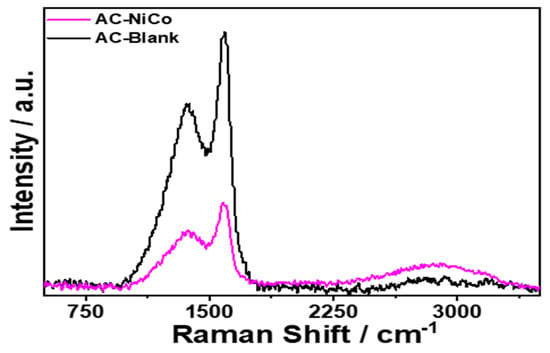
Figure 8.
Raman spectra for activated carbon (AC) with and without nickel cobalt doping (AC-NiCo).
4. Conclusions
In conclusion, the transformation of fennel flower waste into activated carbon emerges as a promising avenue for unlocking the potential of highly efficient hydrogen evolution. Harnessing the inherent properties of this unconventional source, researchers stand poised to pioneer a new era of sustainable catalysts for hydrogen production. By delving deeper into activation techniques and unraveling the intricate structural nuances of the resulting carbon material, novel pathways for green energy innovation can be charted. Furthermore, employing advanced characterization tools such as TEM, SEM, XPS, XRD, and FTIR promises to unveil the hidden intricacies of fennel-flower-waste-derived activated carbon, propelling its application in hydrogen evolution reactions to the forefront of renewable energy endeavors. Together, these endeavors illuminate a path toward a greener future, powered by the transformative potential of waste-to-energy solutions. Our research reveals the promising potential of activated carbon synthesized from fennel flower waste in facilitating efficient hydrogen evolution for renewable energy systems. Previous scholarly works have examined the properties of biomass waste materials and advocated for further exploration in this domain. To enhance the qualities of the activated carbon derived from fennel flower waste, it is advisable to investigate alternative activation methodologies and parameters, aligning with the established theoretical frameworks. Variations in the activation temperatures, durations, and the nature of the activating agents can augment the porosity and surface area of the activated carbon, thereby amplifying its catalytic potency in hydrogen evolution reactions (HERs). Moreover, exploring diverse metal incorporation strategies, including permutations in metal combinations and loading quantities, could elevate the catalytic performance of the activated carbon catalyst. Future research endeavors should concentrate on elucidating the underlying mechanisms that govern the catalytic activity of fennel-flower-waste-derived activated carbon in HERs. Leveraging advanced characterization techniques such as transmission electron microscopy (TEM), scanning electron microscopy (SEM), X-ray photoelectron spectroscopy (XPS), X-ray diffraction (XRD), and Fourier-transform infrared spectroscopy (FTIR) to analyze the structural features and surface chemistry of the activated carbon catalyst can yield invaluable insights into its electrochemical performance. These insights can pave the way for optimizing the catalyst’s design and performance, contributing to the advancement of renewable energy technologies.
Author Contributions
Conceptualization, M.H.S. and M.H.; methodology, M.H.S.; software, M.B.A.; validation, Z.B. and N.A.; formal analysis, H.M.I.; investigation, N.A.; resources, N.A.-Q.; data curation, M.H.; writing—original draft preparation, M.B.A., Z.B. and H.M.I.; writing—review and editing, M.H.S.; visualization, N.A.-Q.; supervision, M.H.S.; project administration, M.H.; funding acquisition, N.A.-Q. All authors have read and agreed to the published version of the manuscript.
Funding
This research was funded by the Qatar National Research Fund, a member of Qatar Foundation, and is recognized for providing the UREP award [UREP30-105-1-020] that made this research possible.
Institutional Review Board Statement
Not applicable.
Informed Consent Statement
Not applicable.
Data Availability Statement
The original data and findings presented in this study are available within the article; for any additional questions, please contact the corresponding author.
Acknowledgments
The authors express profound gratitude to the Central Laboratories Unit (CLU) at Qatar University for their invaluable guidance throughout this research.
Conflicts of Interest
The authors declare no conflicts of interest.
References
- Boretti, A.; Rosa, L. Reassessing the projections of the world water development report. NPJ Clean Water 2019, 2, 15. [Google Scholar] [CrossRef]
- Charkiewicz, A.E.; Backstrand, J.R. Lead toxicity and pollution in Poland. Int. J. Environ. Res. Public Health 2020, 17, 4385. [Google Scholar] [CrossRef] [PubMed]
- Cheekatamarla, P. Hydrogen and the Global Energy Transition—Path to Sustainability and Adoption across All Economic Sectors. Energies 2024, 17, 807. [Google Scholar] [CrossRef]
- Abdel-Basset, M.; Gamal, A.; Chakrabortty, R.K.; Ryan, M.J. Evaluation approach for sustainable renewable energy systems under uncertain environment: A case study. Renew. Energy 2021, 168, 1073–1095. [Google Scholar] [CrossRef]
- Zhang, X.; Zhao, L.; Wang, A.; Zhang, T.; Zhang, T.N. P-co-doped Activated carbon derived from coconut shells for highly efficient supercapacitors. Chem. Eng. J. 2020, 394, 124858. [Google Scholar]
- Wang, Z.-D.; Xia, T.; Li, Z.-H.; Shao, M.-F. A review of carbon-based catalysts and catalyst supports for simultaneous organic electro-oxidation and hydrogen evolution reactions. New Carbon Mater. 2024, 39, 67–77. [Google Scholar] [CrossRef]
- Khan, M.; Musharaf, S. Foeniculum vulgare Mill. A medicinal herb. Med. Plant Res. 2014, 32, 4. [Google Scholar]
- Godlewska, K.; Ronga, D.; Michalak, I. Plant extracts-importance in sustainable agriculture. Ital. J. Agron. 2021, 16, 1851. [Google Scholar] [CrossRef]
- Bigdeloo, M.; Kowsari, E.; Ehsani, A.; Ramakrishna, S.; Chinnappan, A. Activated carbon derived from fennel flower waste as high-efficient sustainable materials for improving cycle stability and capacitance performance of electroactive nanocomposite of conductive polymer. J. Energy Storage 2022, 55, 105793. [Google Scholar] [CrossRef]
- Rani, G.M.; Pathania, D.; Umapathi, R.; Rustagi, S.; Huh, Y.S.; Gupta, V.K.; Kaushik, A.; Chaudhary, V. Agro-waste to sustainable energy: A green strategy of converting agricultural waste to nano-enabled energy applications. Sci. Total Environ. 2023, 875, 162667. [Google Scholar]
- Iwanow, M.; Gärtner, T.; Sieber, V.; König, B. Activated carbon as catalyst support: Precursors, preparation, modification and characterization. Beilstein J. Org. Chem. 2020, 16, 1188–1202. [Google Scholar] [CrossRef]
- Ferrari, A.C.; Basko, D.M. Raman spectroscopy as a versatile tool for studying the properties of graphene. Nat. Nanotechnol. 2013, 8, 235–246. [Google Scholar] [CrossRef] [PubMed]
- Liu, X.; Zhang, S.; Wen, X.; Chen, X.; Wen, Y.; Shi, X.; Mijowska, E. High yield conversion of biowaste coffee grounds into hierarchical porous carbon for superior capacitive energy storage. Sci. Rep. 2020, 10, 3518. [Google Scholar] [CrossRef] [PubMed]
- Mabungela, N.; Shooto, N.D.; Dikio, E.D.; Modise, S.J.; Monapathi, M.E.; Mtunzi, F.M.; Xaba, T.; Naidoo, E.B. Multi- application fennel-based composites for the adsorption of Cr (VI) ions from water and control of Escherichia coli and Staphylococcus aureus. Environ. Chem. Ecotoxicol. 2022, 4, 171–185. [Google Scholar] [CrossRef]
- Ehsani, A.; Bigdeloo, M.; Alamgholiloo, H.; Asgari, E.; Sheikhmohammadi, A.; Nazari, S.; Hashemzadeh, B.; Ghasemian, N. Ternary nanocomposite of TiO2-ZnO/MCM-41: Synthesis and electrochemical performance in supercapacitors. J. Energy Storage 2022, 50, 104633. [Google Scholar] [CrossRef]
- Mola, B.A.; Mani, G.; Sambasivam, S.; Pallavolu, M.R.; Ghfar, A.A.; Ouladsmane, M.; Alsawat, M.; Reddy, N.R.; Noh, Y.; Jilcha, S.K.; et al. Crafting nanoflower-built MnCo2S4 anchored to Ni foam as a prominent energy conversion and energy storage electrode for high-performance supercapacitor applications. J. Energy Storage 2021, 43, 103155. [Google Scholar] [CrossRef]
- Palaniappan, N.; Cole, I.S.; Kuznetsov, A.E. Experimental and computational studies of graphene oxide covalently functionalized by octylamine: Electrochemical stability, hydrogen evolution, and corrosion inhibition of the AZ13 Mg alloy in 3.5% NaCl. RSC Adv. 2020, 10, 11426–11434. [Google Scholar] [CrossRef] [PubMed]
- Kahriz, P.K.; Mahdavi, H.; Ehsani, A.; Heidari, A.A.; Bigdeloo, M. Influence of synthesized functionalized reduced graphene oxide aerogel with 4, 4′-methylenedianiline as reducing agent on electrochemical and pseudocapacitance performance of poly orthoaminophenol electroactive film. Electrochim. Acta 2020, 354, 136736. [Google Scholar] [CrossRef]
Disclaimer/Publisher’s Note: The statements, opinions and data contained in all publications are solely those of the individual author(s) and contributor(s) and not of MDPI and/or the editor(s). MDPI and/or the editor(s) disclaim responsibility for any injury to people or property resulting from any ideas, methods, instructions or products referred to in the content. |
© 2024 by the authors. Licensee MDPI, Basel, Switzerland. This article is an open access article distributed under the terms and conditions of the Creative Commons Attribution (CC BY) license (https://creativecommons.org/licenses/by/4.0/).